For the second year in a row, Design Master Software conducted a survey of engineers and designers in the MEP industry to learn about their experiences using building information modeling (BIM). The survey was conducted online. A link to the survey was included in our monthly newsletter, on various LinkedIn groups, on Autodesk’s AutoCAD MEP forum, on AUGI’s Revit MEP forum, and at the bottom of our MEP Ninja comic pages.
We first conducted this survey last year. Comparing this year’s results with last year’s, we see two significant trends in the industry:
- The number of projects modeled in 3D for collision detection has not changed in the last year.
- When a project is modeled in 3D, more of the various disciplines are included in the 3D model.
Demographics
This year, 84 people responded to the survey, 74 of whom were located in the United States or Canada. Like last year, most of the respondents worked at consulting companies and at large companies.


We asked which BIM programs the respondents use. Half the respondents in the survey use Revit MEP, half use AutoCAD MEP, and a little less than half use Design Master (DM) HVAC, Electrical, or Plumbing. There was significant overlap between the three programs, with many respondents using a combination of two or three of the programs. Eight respondents did not use any of these three programs. Due to the fact that we sponsored the survey and advertised it in our monthly newsletter, the number of DM users relative to the industry as a whole is probably overstated.



Types of BIM Used
As we said in last year’s article, it is important to remember that BIM and 3D are not the same thing. You can use BIM for many other purposes, such as automated design, material takeoffs, and green design. We wanted to know how the various types of BIM were being used on projects, not just 3D collision detection (3D-BIM).
We found that 72% of respondents are using 3D-BIM on some of their projects. Only 22% of respondents said that they do not use BIM on their projects. Comparing the results from last year with this year, they are essentially unchanged. The MEP industry looks the same this year as it did last year regarding the use of BIM on projects.
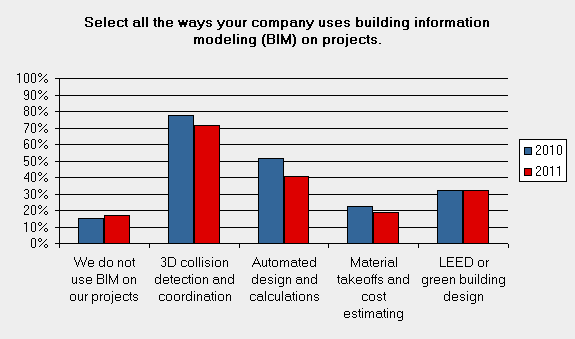
There are differences in the use of BIM between firms of difference sizes. In 2010, large firms with more than 50 people used BIM in every category more frequently than small firms. This year, that is still the case for all categories except automated design. For that category, the use of BIM is approximately the same for large and small firms (38% of large firms versus 43% of small firms).
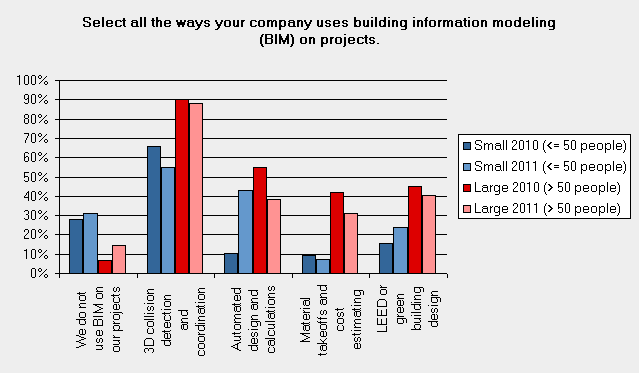
Current Projects Using 3D-BIM
We asked what percentage of current projects use 3D-BIM. Unchanged from last year, 24% of respondents do not do any projects using 3D-BIM. Also unchanged, 62% of respondents use 3D-BIM on less than half their projects. Like last year, most projects this year are not being designed using 3D-BIM.
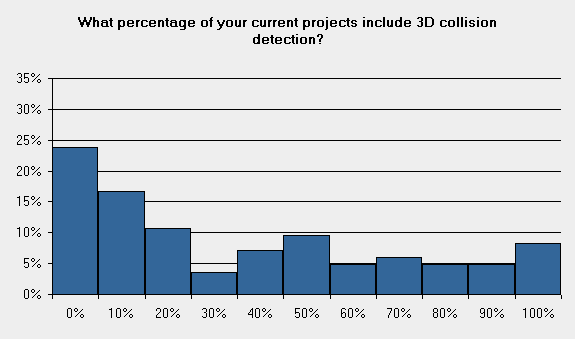
Comparing large firms with small firms again, large firms use 3D-BIM on more of their projects than small firms.
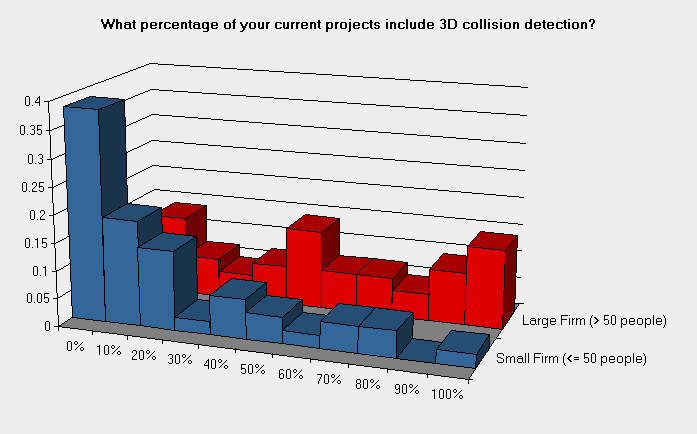
Creating a 3D model and coordinating it with other disciplines is a time-consuming process. We asked whether firms are able to charge for the additional time required on projects that use 3D-BIM. Last year, 40% charged more. That increased this year to 56% charging more when doing 3D-BIM.
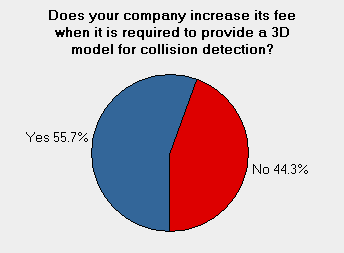
When projects are modeled in 3D, most disciplines are included. Architectural, structural, and mechanical systems still lead the way for being consistently modeled in 3D. This result is not surprising. Those are the systems that most frequently have conflicts with each other. Electrical and plumbing continue to lag behind.
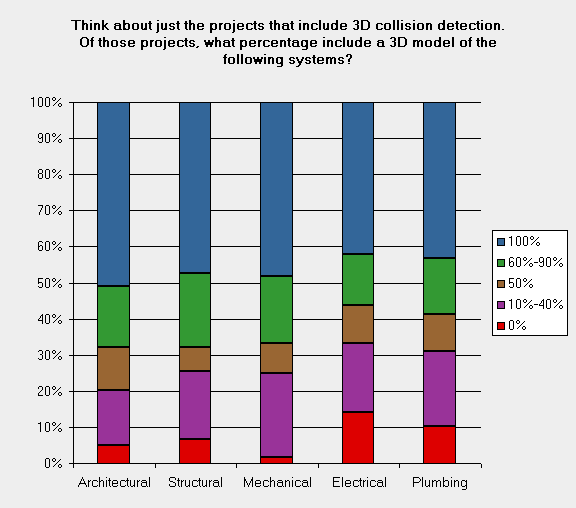
The frequency that each discipline is modeled in 3D increased significantly this year compared to last year. In 2010, there were lots of projects modeled in 3D where multiple pieces were not included. In 2011, when a project is modeled in 3D, it more frequently includes a model of all the disciplines. The results for 2011 matched or exceeded the expectation for three years in the future from last year. The industry is maturing quickly in this regard. When a 3D model is called for in a project, everyone is getting on board to produce one.
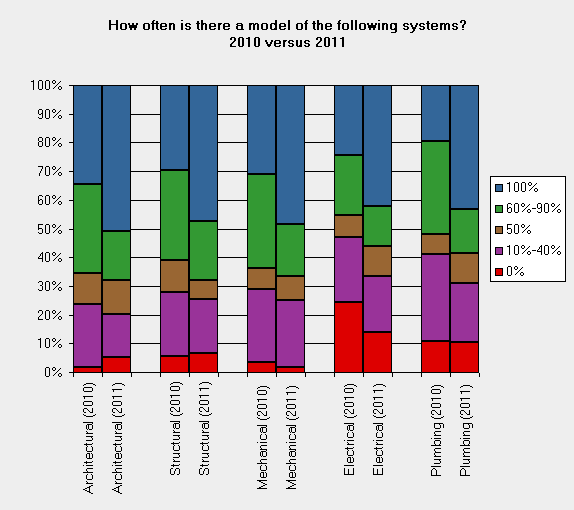
Future Projects Using 3D-BIM
We also asked what percentage of projects in three years would be designed using 3D-BIM. The expectation last year was for projects using 3D-BIM to increase, and that expectation is repeated this year. Both years, 75% of respondents expect to be using 3D-BIM on half or more of their projects in three years, and 30% of respondents expect to be using 3D-BIM on all of their projects in three years.
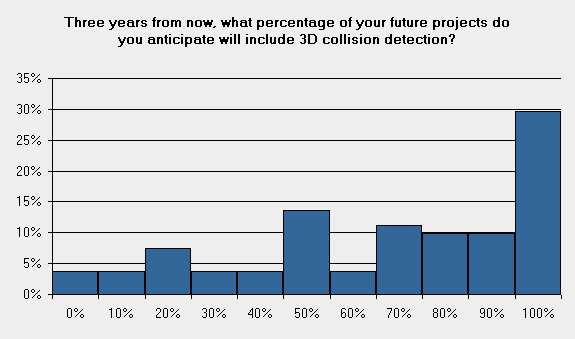
Comparing large firms and small firms again, large firms expect to use 3D-BIM on more projects in 3 years than small firms do. Only 15% of small firms expect all of their work to use 3D-BIM, while 45% of large firms expect that to happen.
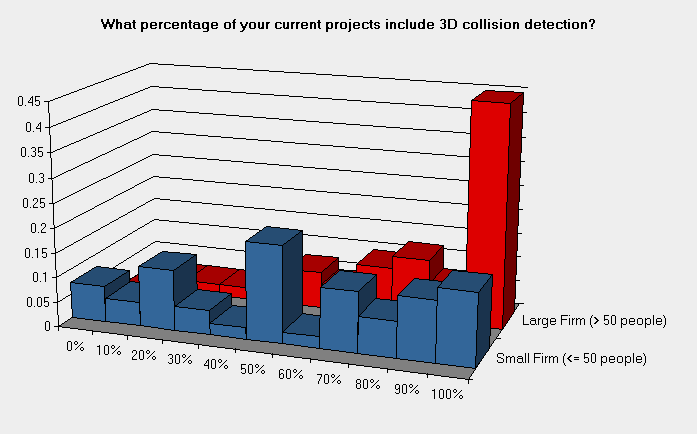
Like last year, the expectation is that all disciplines will be modeled in 3D more frequently in the future.
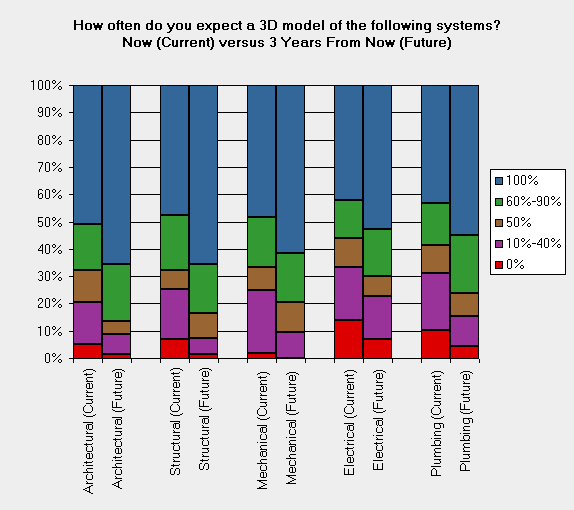
Trends in 3D-BIM
Our original purpose for the survey was to be able to compare trends between years. We now have two years of data and can compare the reported use of 3D-BIM in 2010 and 2011, and the predicted use of 3D-BIM in 2013 and 2014. The reported use this year is also one year closer to the predicted use from last year. Has the industry moved toward or away from last year’s predictions for the future use of 3D-BIM?
The current use of 3D-BIM changed very little between 2010 and 2011. It actually decreased slightly, but not significantly compare to the margin of error in the data. The predicted use of 3D-BIM 3 years in the future also changed very little. The expectations for 2013 in 2010 and for 2014 in 2011 are basically the same. Either expectations are wrong or there will soon be a huge jump in projects requiring 3D-BIM.
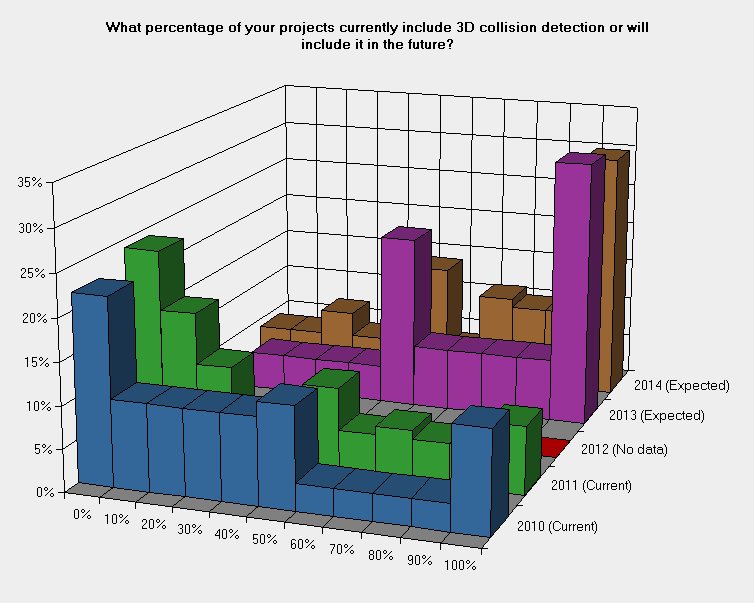
Comparing this year’s survey results with last year’s, there are two trends that we think are emerging.
- Most projects will not be modeled in 3D. The number of projects using 3D-BIM will slowly increase, but it will not be as dramatic as our respondents expect. High profile projects featured in case studies, such as stadiums, hospitals, and skyscrapers in Dubai, will continue to feature 3D collision detection. Routine buildings that do not benefit from 3D-BIM, such as strip mall remodels, banks, chain restaurants, and veterinarian offices, will not use it. These routine projects that do not require 3D-BIM will outnumber complicated projects that do.
- Some projects will be modeled in 3D, and all disciplines will be required to produce a 3D model when this happens. Different parts of the industry have transitioned at different speeds to 3D-BIM. In the next year or two, when a project calls for a 3D model, it will be for the whole project. It will be increasingly unacceptable to have some disciplines not participate in this process.
Be prepared. As we suggested last year, continue to evaluate your BIM and 3D modeling options. There are lots of projects where you will not need them, and those projects are not going away. But more and more projects are requiring them from all disciplines. When those projects come up, you will want to be ready.
